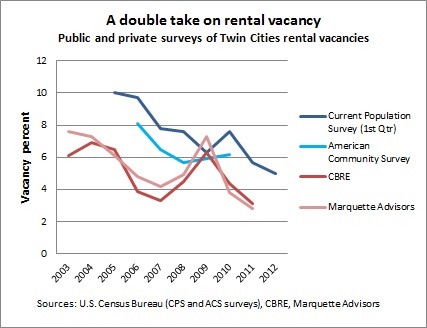While there seems to be more local news today about tight rental markets and new apartment developments, you’ll read or hear very little about rental markets on a national, statewide or even regional scale, and you’ll see even less hard data connected to those reports.
That’s because macro data on rental markets are sparse and decentralized. Most data are very local, and there is little aggregation of market activity like demand, rent levels and other matters the public takes for granted in the single-family housing market. In terms of centralized sources for data across states and cities, they start and end with multifamily permits from the U.S. Census Bureau. These data show that multifamily housing construction dried up after the recession and has only recently started to rebound (see cover article in the July fedgazette).
Other surveys by the Census offer some broad-based data on local markets, but come with considerable caveats. For example, the American Community Survey (ACS) and Current Population Survey (both conducted by the Census) measure vacancy rates in the Twin Cities. Unfortunately, annual data for each run only through 2010—a turning point in many rental markets. CPS offers quarterly vacancy rates for the Twin Cities, but these figures can have seasonal volatility. In any case, results from these two public surveys do not conform particularly well with vacancy surveys conducted by private firms in the Twin Cities (Marquette Advisors, CBRE; see chart).

Other “large” cities in the Ninth District are not large enough to attract much attention from private market research firms. The ACS offers data for smaller metropolitan statistical areas, including those in the district, but they tend to suffer the same caveats about timeliness and congruence with local sources.
As a result, understanding local markets is a hunt-and-peck effort. Local data sources are notoriously spotty, in both their volume and reliability, even for fundamental measures like rent levels and vacancies. Industry sources widely acknowledged the lack of good information on rental markets.
“We struggle with a lack of data,” particularly in outstate markets, said Mary Rippe, head of the Minnesota Multi Housing Association. She said rentals were harder to track because historically there’s been no Multiple Listing Service (MLS) that is standard with home sales (more on this in a bit). Turnover is also much higher for rentals and thus harder to track. Even the definition of vacancy introduces some complexity, as a corporate office might have a different definition of vacancy than a building manager for the same unit (if it’s empty but being repaired or updated, for example).
Some rental associations gather data; some do not. In their defense, local associations need to be wary of market surveys so as not to encourage collusion or rent setting, industry sources pointed out. For those associations that gather local data, some make that information available, but many do not. In more than a half-dozen cities with a rental association, information requests to rental associations via both phone and email were either refused or ignored.
The information gap is partially filled in some cities that publish annual reports on city housing, which typically include a section on rental housing. But most local governments “do not track rents charged by owners, and many communities do not even have a rental registration or license program. So they don’t even know who is operating rental housing in the community,” said Sue Speakman-Gomez, president of HousingLink, a Twin Cities clearinghouse of affordable rental housing information. The organization is trying to fill that void, she said, but acknowledged that “we still have a lot of work to do.”
Private data firms are starting to get their rental toes wet. Companies like Zillow have increased their abilities to identify and market local rental properties; the downside is that aggregate data are thin—there are no historical benchmarks for comparison—and privately held. MLS also has started to include rental housing, but Realtor.com—home of the National Association of Realtors—currently lists fewer than 350,000 units nationwide; this for a nation with about 40 million renter-occupied households, according to the Census.
Even among subjects with a strong policy bent, like affordable housing, surprisingly little centralized data are available that might allow for the analysis of broader patterns. For example, the U.S. Department of Housing and Urban Development confirmed that it does not aggregate waiting lists for various housing assistance programs, nor does any state, despite the fact that local housing authorities are required to gather this information. A check of local housing agencies shows that wait lists for public housing and Section 8 assistance vouchers have skyrocketed. (For more, see the July fedgazette article on low-income rental markets.)
Ron Wirtz is a Minneapolis Fed regional outreach director. Ron tracks current business conditions, with a focus on employment and wages, construction, real estate, consumer spending, and tourism. In this role, he networks with businesses in the Bank’s six-state region and gives frequent speeches on economic conditions. Follow him on Twitter @RonWirtz.





